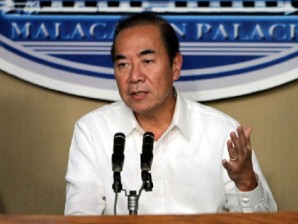MANILA, Philippines—Did you know that Burgos Circle in Fort Bonifacio, Taguig City, has a five-story structure underneath it where floodwater is impounded and later released into Manila Bay?
The government is looking at it, or the principle behind it, in a search for a model for a water-impounding system that it plans to build in the Marikina watershed, the main source of floodwaters that swamped Marikina and neighboring cities during last week’s deluge in Metro Manila.
“What we’re looking at is to impound or retard the amount of water together with the runoff upstream. It’s been effective in many countries and we’ve tried that in Fort Bonifacio,” Public Works Secretary Rogelio Singson said in a phone interview on Saturday.
At Burgos Circle’s cistern, which Singson helped design when he was still with the private sector, floodwater is stored and, after the rains, is pumped into creeks that flow into the bay, Singson said.
Metro projects
During his tour of flooded areas on Thursday, President Aquino said catch basins in the Marikina watershed, a ring-road dike along Laguna de Bay, and a dike and pumping station in the Camanava (Caloocan, Malabon, Navotas and Valenzuela) area would be built in two to three years to deal with perennial flooding in Metro Manila.
For years, runoff from the 26,000-hectare, denuded Marikina watershed has been a major cause of flooding in areas downstream, including Antipolo City, Montalban, San Mateo and Tanay towns, all in Rizal province, and Marikina City.
During last week’s torrential monsoon rains, runoff from the watershed swelled the Marikina River and swamped surrounding areas and parts of Rizal, as in September 2009 when Tropical Storm “Ondoy” sank the metropolis.
On Friday night, the river swelled anew after hours of heavy rain, causing panic and prompting evacuations of residents of areas threatened by flooding.
Not Marikina territory
“All of the rainwater goes down to us. We suffer a lot from the floods, and 98 percent of that comes from the watershed,” Marikina Rep. Federico Romero Quimbo said by phone. “And there’s not a single foot in the watershed that belongs to Marikina.”
Quimbo said the water-impounding project was now on the drawing board at the Department of Public Works and Highways, and this could be either a dam or a diversion tunnel.
Dual role
But unlike the Burgos Circle cistern, Singson said the proposed project in the Marikina watershed would have a dual role: Impound water to protect the residents downstream, and provide the capital another source of potable water.
“We’ll use storm water for domestic use,” Singson said.
That is the idea, Quimbo said. He added that he was optimistic that the project would become a reality during the Aquino administration.
“That has always been a pipe dream; an empty promise in the past,” he said. “But now we’re strongly convinced it will become a reality. The President will not say anything unless he means it. And Secretary Singson has the competence to do it.”
To cost billions
Since public works officials have yet to present the detailed plans, Budget Secretary Florencio Abad could not give the exact cost of the project. He said, however, that“this will be in the billions of pesos.”
“The immediate and short-term requirements may be drawn from budgetary allocations, but the medium- and long-term funding will have to be drawn, in addition, from ODA (official development assistance) and PPP (public-private partnership) funding,” Abad said.
PPP funds are often allotted for “self-liquidating projects” like water supply, hydropower, solid waste management and sewage services, he said.
Abad agreed with the principle behind the project.
Contain runoff
“We cannot mitigate the flooding unless we can significantly contain the runoff, especially [water] cascading from the mountains and released from dams,” Abad said.
The good thing is that the government could look at this situation and “see how we may harness it to benefit, instead of, harm” people, he said.
“How can we now use the excess water for irrigation, aquaculture, potable water supply, reforestation and even for hydropower?” he said.
